# Toward Concurrency
:::info
主講人: [jserv](http://wiki.csie.ncku.edu.tw/User/jserv)
:::
==[直播錄影](https://www.youtube.com/watch?v=3mkug2ygdIs)== (Oct 18, 2016)
## 軟體開發現況
* [The Free Lunch Is Over: A Fundamental Turn Toward Concurrency in Software](http://www.gotw.ca/publications/concurrency-ddj.htm)
* Free (performance) lunch 指的是程式設計的效能可以透過 CPU 時脈的進步而得到改善。會說 over 是因為 CPU 的時脈無法得到更進一步的增加,由於耗電和散熱的問題,所以程式設計師必須要修改程式才能改善效能
* 文章中 `Figure 1`,可以看到 CPU 時脈並沒有隨著電晶體數量而增加,反而是趨緩了

* 以前 CPU 增進效能的手段
* Clock speed
* Execution Optimization
* Pipelining、Branch prediction
* Out-of-order execution 還要注意不能讓原本程式崩潰 (read/write reorder)
* Cache:盡量減少存取 Main memory 的機會
* 現在 CPU 增進效能的手段
* Hyperthreading: 在 single CPU 上同時執行多個 thread,但是共用 ALU、FPU
* Multicore:多個 CPU
* 迷思:`2 x 3GHz < 6GHz`
* Cache
* 軟體開發革命 (Software development revolution) 是源自於存在一陣子的技術 (擁有成熟的銷售商和工具支援),而非新技術一出現即發生。
## Functional Programming
* [Why are functional languages considered a boon for multi threaded environments?](http://stackoverflow.com/questions/2909282/why-are-functional-languages-considered-a-boon-for-multi-threaded-environments)
* [It’s Time to Get Good at Functional Programming](http://www.drdobbs.com/article/print?articleId=212201710&siteSectionName=tools)
* [Don’t Be Scared Of Functional Programming](https://www.smashingmagazine.com/2014/07/dont-be-scared-of-functional-programming/)
* [Functional programming in C](https://lucabolognese.wordpress.com/2013/01/04/functional-programming-in-c/)
## 不是探討 Synchronization 而已
* [Mutexes and Semaphores Demystified](http://www.barrgroup.com/Embedded-Systems/How-To/RTOS-Mutex-Semaphore)
* [Mutex vs. Semaphores – Part 1: Semaphores](https://blog.feabhas.com/2009/09/mutex-vs-semaphores-%E2%80%93-part-1-semaphores/)
* [Mutex vs. Semaphores – Part 2: The Mutex](https://blog.feabhas.com/2009/09/mutex-vs-semaphores-%E2%80%93-part-2-the-mutex/)
* [Mutex vs. Semaphores – Part 3: Mutual Exclusion Problems](https://blog.feabhas.com/2009/10/mutex-vs-semaphores-%E2%80%93-part-3-final-part-mutual-exclusion-problems/)
## Concurrency (並行) vs. Parallelism (平行)
* [Concurrency is not Parallelism](https://blog.golang.org/concurrency-is-not-parallelism)[,](https://www.youtube.com/watch?v=cN_DpYBzKso) by Rob Pike
* [投影片](https://talks.golang.org/2012/waza.slide#1)
* [錄影](https://youtu.be/qmg1CF3gZQ0); [後續 stackoverflow 討論](http://stackoverflow.com/questions/11700953/concurrency-is-not-parallelism)
* Concurrency 對軟體設計的影響
* 想要充分使用到 CPU 的資源
* 程式越來越有機會造成 CPU-bound。雖然主要還是 IO-bound 等,但如果 CPU 時脈無法增加,而其他存取方式速度變快,最後會發生 CPU-bound
* 軟體效能優化將會越來越重要
* 程式語言必須好好處理 concurrency
* **Concurrency** 是指程式架構,將程式拆開成多個可獨立運作的工作。eg:drivers,都可以獨立運作,但不需要平行化。
* 拆開多個的工作不一定要同時運行
* 多個工作在單核心 CPU 上運行
* **Parallelism** 是指程式執行,同時執行多個程式。Concurrency 可能會用到 parallelism,但不一定要用 parallelism 才能實現 concurrency。eg:Vector dot product
* 程式會同時執行 (例如:分支後,同時執行,再收集結果)
* 一個工作在多核心 CPU 上運行
Rob Pike 用地鼠燒書做例子:

如果今天增加多一只地鼠,一個推車或多一個焚燒爐,這樣有機會作到更好的資源使用率,但我們不能保證兩只或更多地鼠會同時進行(可能只有有限的火爐(在單核系統中只能允許一次進行一次的燒書工作,那樣就沒有效率了)

以 Concurrency 的方式去作業,能夠以不同的解構方式去進行,可以是三個地鼠分別負責一部分的工作 (decomposition)

其中也可以 Parallelism:

或

**Concurrency:** 是指程式架構,將程式拆開成多個可獨立運作的工作,像是驅動程式都可獨立運作,但不需要平行化
* 拆開多個的工作不一定要同時運行
* 多個工作在單核心 CPU 上運行
**Parallelism:** 是指程式執行,同時執行多個程式。Concurrency 可能會用到 parallelism,但不一定要用 parallelism 才能實現 concurrency。eg:Vector dot product
* 程式會同時執行 (例如:fork 後,同時執行,再收集結果 [join])
* 一個工作在多核心 CPU 上運行
在線上教材 [Introduction to OpenMP](https://www.youtube.com/watch?v=6jFkNjhJ-Z4) 做了以下整理:
- [ ] Concurrent (並行)
* 工作可拆分成「獨立執行」的部份, 這樣「可以」讓很多事情一起做, 但是「不一定」要真的同時做。下方情境:

* 展示具有並行性,但不去同時執行。
* 並行性是種「架構程式」的概念。寫下一段程式之前, 思考問題架構時就決定好的。
- [ ] Parallel (平行)
* 把規劃好, 能夠並行的程式, 分配給不同執行緒, 並讓他們同時執行。

* 「平行」是一種選擇。
* 假設有天我在程式發現需要做內積,可用迴圈逐一存取 3 個元素做(沒有平行化), 也可用 3 個執行緒同時執行每個相應位置元素的乘法 (有平行化)。這裡「要不要做平行化」只是種「選擇」
:::info
只是舉例, 為內積故意創造執行緒, 有可能光是花在建立新執行緒上的時間與資源就比內積本身還要多
:::
### Hello World
考慮以下使用 OpenMP 的程式碼:
```C
#include<stdio.h>
#include<omp.h>
int main()
{
#pragma omp parallel
{
int id = omp_get_thread_num();
printf("hello, World Thread %d\n", id);
}
}
```
編譯程式時要加上 `-fopenmp` 選項。 編譯完執行之後得到以下結果:
```
hello, World Thread 0
hello, World Thread 1
hello, World Thread 3
hello, World Thread 2
```
(實際上順序是不一定的)
在這個程式中 :
1. `#pragma omp parallel` 下面以大括號括起來的東西, 是平行化的區塊。 程式執行到這裡的時候, 會跟作業系統要一堆thread, 每個 thread 都去執行這個區塊東西。 至於有多少 thread , 因為沒有指定, 所以就是一個預設數目。
2. 在平行區塊裡面, 可以用 `omp_get_thread_num()` 來知道不同 thread 的編號, 這個編號會從0, 1, 2...一直編下去。
[ **Independentability** ]
換個觀點來理解 [ [source](http://stackoverflow.com/questions/1050222/concurrency-vs-parallelism-what-is-the-difference) ]
* **Concurrency:** If two or more problems are solved by a single processor.
* multiple execution flows with the potential to share resources
* Example: two threads competing for a I/O port.
* the separation of tasks to provide **interleaved execution**
* Concurrency solves the problem of having scarce CPU resources and many tasks. So, you create threads or independent paths of execution through code in order to share time on the scarce resource. Up until recently, concurrency has dominated the discussion because of CPU availability.

* **Parallelism:** If one problem is solved by multiple processors.
* splitting a problem in multiple similar chunks.
* Example: parsing a big file by running two processes on every half of the file.
* the **simultaneous execution of multiple pieces of work** in order to increase speed
* Parallelism solves the problem of finding enough tasks and appropriate tasks (ones that can be split apart correctly) and distributing them over plentiful CPU resources. Parallelism has always been around of course, but it’s coming to the forefront because multi-core processors are so cheap.

## Concurrency 系列文章 (繁體中文)
* [Concurrency系列(一): 理解Concurrency之路](http://opass.logdown.com/posts/784600-concurrency-series-1-the-road-to-understand-concurrency)
* [Concurrency系列(二): 從Sequenced-Before開始說起](http://opass.logdown.com/posts/788206-concurrency-series-2-starting-from-sequenced-before)
* [Concurrency系列(三): 朝Happens-Before邁進](http://opass.logdown.com/posts/797113-concurrency-series-3-happens-before)
* [Concurrency系列(四): 與Synchronizes-With同在](http://opass.logdown.com/posts/797957-concurrency-series-4-be-with-the-synchronizes-with-relation)
* [Concurrency系列(五): Sequential Consistency的代價](http://opass.logdown.com/posts/809449-concurrency-series-5-the-price-of-sequential-consistency)
* 冼鏡光的[並行計算投影片](http://www.csl.mtu.edu/cs3331.ck/www/3331-slides.html)
* [Art of Multiprocessor Programming](https://www.e-reading.club/bookreader.php/134637/Herlihy,_Shavit_-_The_art_of_multiprocessor_programming.pdf)
## Concurrency
- [ ] [An Introduction to Lock-Free Programming](http://preshing.com/20120612/an-introduction-to-lock-free-programming/)
* Lock-Free ([reference](http://www.cnblogs.com/gaochundong/p/lock_free_programming.html)):

* 特性:若在某個執行緒被 lock-up,絕對不會影響其他執行緒的運行 (non-blocking),lock-free 不是說完全不用 mutex lock而是指「執行緒的執行不會被其他 lock 鎖住」
* Lock-free 需要的機制::

* Atomic Read-Modify-Write Operations
* 目前各平台都有提供相關的 API,如 Windows 下的 `_InterlockedIncrement`、iOS 下的 `OSAtomicAdd32` 以及 C\++11 中的 `std::atomic<int>::fetch_add`。
* 值得一提的是,C\++11 的 atomic operation 無法保證是 lock-free 的,必須透過 `std::atomic<>::is_lock_free` 來確認
* RMW operation: 確保多執行緒中同時只有一個會存取到同一個地址
* Compare-And-Swap Loops:經由 CAS 搭配迴圈來確保 Atomic
* 在處理CAS Loop時要特別小心 [ABA Problem](https://en.wikipedia.org/wiki/ABA_problem): ABA 問題是若兩個執行緒同時對一個記憶體內容進行操作,但優先執行完畢的執行緒把原值 A 改爲 B 又改回 A,這樣後執行的執行緒將會讀取錯誤的資料:

上圖可見,T1 要執行 pop,但是當他在讀取 A->B 時,T2 搶佔了 T1 執行 push 的動作( Top->A->C),結束之後 T1 (已經 pop 掉 A,所以 T1 的 Top 指向 B) 回來檢查 Top 跟一開始一樣,指向A,所以 CAS 完成,但結果顯然錯誤,因爲 B 已被 push 並釋放了記憶體位置。
* 解決辦法:Garbage Collection(確保記憶體不再需要時才釋放)
* Sequential Consistency:
* 對於每個獨立的處理單元,執行時都維持程式的順序(Program Order)
* 整個程式以某種順序在所有處理器上執行
* Compiler Barrier :防止編譯器優化所產生的reordering,[用法參考](http://dreamrunner.org/blog/2014/06/28/qian-tan-memory-reordering/)
- [ ] [Acquire and Release Semantics](http://preshing.com/20120913/acquire-and-release-semantics/)
透過 Acquire and Release Semantics 來限制優化,讓記憶體相關操作必須在特定語句前後完成。
```
+----------------------------------------+
| Acquire Semantics |
+----------------------------------------+ <<= 所有記憶體操作要在此線之下執行
| |
| .... |
| |
+----------------------------------------+ <<= 所有記憶體操作要在此線之前執行
| Release Semantics |
+----------------------------------------+
```
* Memory Barrier
透過一些指令防止 CPU 對一些記憶體操作進行重排。共分4種 Barrier。

* LoadLoad
* StoreStore
* LoadStore
* StoreLoad
- [ ] [Weak vs. Strong Memory Models](http://preshing.com/20120930/weak-vs-strong-memory-models/)

所謂的 Weak 就是指有很大的機率會將 load/store 指令進行重排,而 Strong 則相反
* 4 種模式
* Weak memory model: 可能存在所有的memory reordering
* Weak with data dependency ordering:可能存在storeload和storestore的reordering (load 的順序必能被保證)
* Usually Strong: 保證 acquire and release semantic 的執行,所以只存在storeload reordering
* Sequentially consistent: 全部被保證順序
- [ ] [Concurrency Kit](http://concurrencykit.org/): Concurrency primitives, safe memory reclamation mechanisms and non-blocking data structures for the research, design and implementation of high performance concurrent systems.
- [ ] [concurrency](http://www.slideshare.net/aj0612/studying-concurrency)
- [ ] [Memory Barriers in the Linux Kernel: Semantics and Practices](https://www.youtube.com/watch?v=Ykk_U7LX_jA)
## Fork-Join Model
典型的程式開發模式,由以下 3 階段組成:
1. 準備進入要平行化的區域時, fork 出多個執行單元。「合作」的執行緒稱為 "team of thread"。注意:這裡的 "fork" 並非 `fork()` 系統呼叫

2. 這些執行單元合力執行給定的工作

3. 工作完成之後, 又回到 fork 之前, 單一執行緒的狀態。這過程稱為 join。

fork-join model 就是不斷重複上述過程。概念上來說, fork 階段的時候,記憶體佈局會從原本這樣:

轉變為以下:

每個執行單元都有自己的 stack , 但跟本來的執行執行單元共用 text, heap 與 data section。

### 透過 OpenMP 指定執行緒
可採用以下形式:
```C
int A[10000];
omp_set_num_threads(n); //n是執行緒的數目
#pragma omp parallel
{
/* 大括號裏面是每一個執行緒要做的東西 */
int ID = omp_get_thread_num();
do_something(id, A)
}
```
:::info
每個執行緒的「編號」可由 `omp_get_thread_num()` 得知。
:::
注意:
* `#pragma` 區塊外面宣告的變數, 會在每個執行緒的可視範圍內
* `#pragma` 區域裡面宣告的變數, 會在每個執行緒自己的stack裏面, 所以可視範圍只有該執行緒。
* `omp_get_thread_num()` 編號會固定是 0, 1...n-1, 跟POSIX下的 tid 或 pid 行為不同。
* 作業系統實際給的執行緒數目, 可能會比本來要求的少。真實分配到的執行緒數目可以在平行區塊裡面用 `omp_get_num_threads()` 來知道。這是一件很重要的事。
### 同步
同步的概念大致分以下兩類:
* Barrier : 等大家都執行完, 再往下繼續做

跟wait()很像。 openMP再這裡對應的是 :
```
#pragma omp barrier
```
* Mutal Exclusion : 確保一次只有一個執行緒會執行某一段程式。 這段程式叫作 critical section.

```
#pragma omp critical
{
/* critical region */
}
```
#### Atomic Operation
用下面的關鍵字
```
#pragma omp atomic
/* atomic operation */
```
這裡的atomic operation只能是下面幾個 :
* x binop= a
* x++, x--, ++x, --x
>> 到這裡可以發現本來 pthread 要寫很多(e.g. 傳入函式指標、變數要包成結構體傳進去等等)的東西,openMP 都把它變得更精簡。
## 精簡化的語法
有一些功能很常用, 比如說平行化 for 迴圈, 如果每次都要寫一遍執行緒 id, 確認執行緒數目...會有很多 code 花在這些例行的準備上。 所以針對這些常用的平行策略, openMP 提供了更精減的語法。
### for 迴圈
如果要把 for 迴圈平行化, 要做下面的事 :
```C
int A[10000];
int real_thread;
omp_set_num_threads(n); //n是執行緒的數目
#pragma omp parallel
{
/* 大括號裏面是每一個執行緒要做的東西 */
real_thread = omp_get_num_threads();
int id = omp_get_thread_num();
for(int i = if; i < STEP; i += real_thread)
do_something(id, A)
}
```
但是 OpenMP 提供了更簡單的語法 :
```C
int A[10000];
omp_set_num_threads(n); //n是執行緒的數目
#pragma omp parallel
{
#pragma omp for
{
for(int i = if; i < STEP; i ++)
do_something(id, A);
}
}
```
就可以自動把迴圏拆開。 更簡單的寫法是 :
```C
int A[10000];
omp_set_num_threads(n); //n是執行緒的數目
#pragma omp parallel for
for(int i = if; i < STEP; i ++)
do_something(id, A);
```
### Reduction
考慮下面這個程式:
```C
int sum = 0;
int A[10000];
omp_set_num_threads(n); //n是執行緒的數目
#pragma omp parallel for
for(int i = if; i < STEP; i ++)
sum += A[i];
```
思考一下之前的平行化策略, 可以發現再這裡並不管用, 因為 sum 會一直用到。 但是這又是寫迴圈很常出現的狀況。 openMP 針對這點提供了 reduction 語法。 以這段程式為例, 可以透過下面這個語法來平行化 :
```C
int sum = 0;
int A[10000];
omp_set_num_threads(n); //n是執行緒的數目
#pragma omp parallel for resuction(+:sum)
for(int i = if; i < STEP; i ++)
sum += A[i];
```
## Process vs. Thread vs. Coroutines
* With threads, the operating system switches running tasks **preemptive**ly according to its scheduling algorithm.
* [SMT (Simultaneous Multithreading), VMT(Vertical Multithreading)](http://www.fujitsu.com/global/products/computing/servers/unix/sparc-enterprise/technology/performance/processor.html)

* With coroutines, the programmer chooses, meaning tasks are cooperatively multitasked by pausing and resuming functions at set points.
* coroutine switches are cooperative, meaning the programmer controls when a switch will happen.
* The kernel is not involved in coroutine switches.
一圖勝千語:

將函式呼叫從原本的面貌: [ [source](http://www.csl.mtu.edu/cs4411.ck/www/NOTES/non-local-goto/coroutine.html) ]
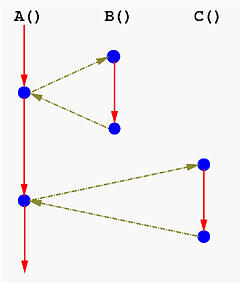
轉換成以下:

C 程式實做 coroutines 的手法相當多,像是:
* [switch-case](http://blog.linux.org.tw/~jserv/archives/001848.html)
* [setjmp / longjmp](http://descent-incoming.blogspot.tw/2014/02/coroutine.html)
## POSIX Threads
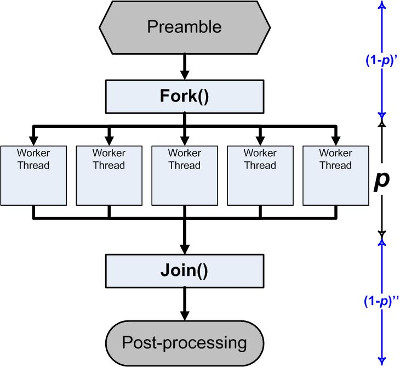
[Getting Started With POSIX Threads](http://www.csie.ntu.edu.tw/~r92094/c++/pthread.txt) (繁體中文翻譯)
## POSIX Thread 實例: 光線追蹤
[2016q1:Homework2](http://wiki.csie.ncku.edu.tw/embedded/2016q1h2) 提到 raytracing 程式,[UCLA Computer Science 35L, Winter 2016 Software Construction](http://web.cs.ucla.edu/classes/winter16/cs35L/) 課程有個作業值得參考:**[S35L_Assign8_Multithreading](https://github.com/maxwyb/CS35L_Assign8_Multithreading)**
編譯與測試
```shell
$ git clone https://github.com/maxwyb/CS35L_Assign8_Multithreading.git raytracing-threads
$ cd raytracing-threads
$ make
$ ./srt 4 > out.ppm
$diff -u out.ppm baseline.ppm
```
預期會得到下圖:

將 `srt` 後面的數字換成 1, 2, 4, 8 來測試執行時間
[ [main.c](https://github.com/maxwyb/CS35L_Assign8_Multithreading/blob/master/main.c) ]
```C=
#include <pthread.h>
pthread_t* threadID = malloc(nthreads * sizeof(pthread_t));
int res = pthread_create(&threadID[t], 0, pixelProcessing, (void *)&intervals[t]);
int res = pthread_join(threadID[t], &retVal);
```
## POSIX Thread
- [ ] [POSIX Threads Programming](https://computing.llnl.gov/tutorials/pthreads/)
* Condition variables provide yet another way for threads to synchronize. While mutexes implement synchronization by controlling thread access to data, ==condition variables allow threads to synchronize based upon the actual value of data.==
* [Priority Inversion on Mars](http://wiki.csie.ncku.edu.tw/embedded/priority-inversion-on-Mars.pdf)
* [Getting Started With POSIX Threads 宋振華](http://www.csie.ntu.edu.tw/~r92094/c++/pthread.txt)
* Condition Variable
* 當有兩個執行緒 A 跟 B。其中 A 需要等到一個變數的狀態轉爲 true 時,才能繼續執行,而這個變數狀態卻掌握在 B 的手中,那 B 將變數狀態改爲 true 後,就能用 signal 來喚醒在等待中的 A
* 如果不這樣作,那麼 A 就會需要一直判斷變數狀態是否改爲true 了,這會損失很多效能成本,且不能保證狀態是否還掌握在其它執行緒手中
* condition variable 總是搭配 mutex lock 使用

Condition variables must be declared with type pthread_cond_t, and must be initialized before they can be used. There are two ways to initialize a condition variable:
1. Statically, when it is declared. For example:
**pthread_cond_t myconvar = PTHREAD_COND_INITIALIZER;**
1. Dynamically, with the pthread_cond_init() routine. The ID of the created condition variable is returned to the calling thread through the _condition_ parameter. This method permits setting condition variable object attributes, _attr_.
**使用案例與情境**
* main 函式建立 3 個執行緒,其中 2 個執行任務並更新名為 "count" 的變數
* 第 3 個執行緒等待 "count" 變數的內含值成為某個指定數值.
```C=
#include <pthread.h>
#include <stdio.h>
#include <stdlib.h>
#define NUM_THREADS 3
#define TCOUNT 10
#define COUNT_LIMIT 12
int count = 0;
int thread_ids[3] = {0,1,2};
pthread_mutex_t count_mutex;
pthread_cond_t count_threshold_cv;
void *inc_count(void *t)
{
long my_id = (long)t;
for (int i = 0; i < TCOUNT; i++) {
pthread_mutex_lock(&count_mutex);
count++;
// Check the value of count and signal waiting thread when condition is
// reached. Note that this occurs while mutex is locked.
if (count == COUNT_LIMIT) {
pthread_cond_signal(&count_threshold_cv);
printf("inc_count(): thread %ld, count = %d Threshold reached.\n",
my_id, count);
}
printf("inc_count(): thread %ld, count = %d, unlocking mutex\n",
my_id, count);
pthread_mutex_unlock(&count_mutex);
/* Do some "work" so threads can alternate on mutex lock */
sleep(1);
}
pthread_exit(NULL);
}
void *watch_count(void *t)
{
long my_id = (long) t;
printf("Starting watch_count(): thread %ld\n", my_id);
/*
Lock mutex and wait for signal. Note that the pthread_cond_wait
routine will automatically and atomically unlock mutex while it waits.
Also, note that if COUNT_LIMIT is reached before this routine is run by
the waiting thread, the loop will be skipped to prevent pthread_cond_wait
from never returning.
*/
pthread_mutex_lock(&count_mutex);
while (count < COUNT_LIMIT) {
pthread_cond_wait(&count_threshold_cv, &count_mutex);
printf("watch_count(): thread %ld Condition signal received.\n", my_id);
count += 125;
printf("watch_count(): thread %ld count now = %d.\n", my_id, count);
}
pthread_mutex_unlock(&count_mutex);
pthread_exit(NULL);
}
int main (int argc, char *argv[])
{
int i, rc;
long t1 = 1, t2 = 2, t3 = 3;
pthread_t threads[3];
pthread_attr_t attr;
/* Initialize mutex and condition variable objects */
pthread_mutex_init(&count_mutex, NULL);
pthread_cond_init (&count_threshold_cv, NULL);
/* For portability, explicitly create threads in a joinable state */
pthread_attr_init(&attr);
pthread_attr_setdetachstate(&attr, PTHREAD_CREATE_JOINABLE);
pthread_create(&threads[0], &attr, watch_count, (void *)t1);
pthread_create(&threads[1], &attr, inc_count, (void *)t2);
pthread_create(&threads[2], &attr, inc_count, (void *)t3);
/* Wait for all threads to complete */
for (i = 0; i < NUM_THREADS; i++)
pthread_join(threads[i], NULL);
printf ("Main(): Waited on %d threads. Done.\n", NUM_THREADS);
/* Clean up and exit */
pthread_attr_destroy(&attr);
pthread_mutex_destroy(&count_mutex);
pthread_cond_destroy(&count_threshold_cv);
pthread_exit(NULL);
}
```
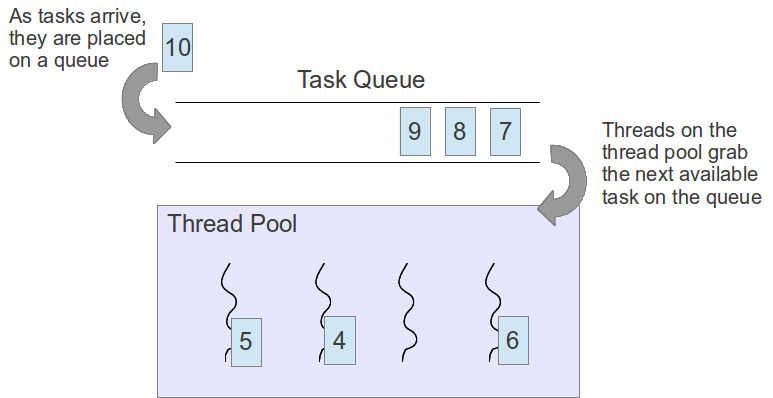
## Thread Pool
[ [source](http://swind.code-life.info/posts/c-thread-pool.html) ]
StackOverFlow 裡頭提及: [Existing threadpool C implementation](http://stackoverflow.com/questions/6297428/existing-threadpool-c-implementation)
裡面有提到幾個 C Thread Pool 的實作範例與可參考的文件
* [threadpool-mbrossard](https://github.com/mbrossard/threadpool)
* [threadpool-jmatthew](http://people.clarkson.edu/~jmatthew/cs644.archive/cs644.fa2001/proj/locksmith/code/ExampleTest/)
* [cthreadpool](http://sourceforge.net/projects/cthpool/)
* [C-Thread-Pool](https://github.com/Pithikos/C-Thread-Pool)
以 threadpool-mbrossard 作為第一個研究的版本,因為仍在維護,而且作者是 [Existing threadpool C implementation](http://stackoverflow.com/questions/6297428/existing-threadpool-c-implementation) 的發文者。
**A simple C thread pool implementation**
Currently, the implementation:
* Works with pthreads only, but API is intentionally opaque to allow other implementations (Windows for instance).
* Starts all threads on creation of the thread pool.
* Reserves one task for signaling the queue is full.
* Stops and joins all worker threads on destroy.
**Thread Pool 的資料結構**
首先 Thread Pool 要有的東西就是 job 或者是 task 讓 Thread 知道他們要做什麼事情。
```C=
typedef struct {
void (*function)(void *);
void *argument;
} threadpool_task_t;
```
所以只要有一個資料結構紀錄要執行的 function pointer 與要傳遞的參數即可。 接下來就是 Thread Pool 本身,他必須存放所有的 Thread 與 Job Queue:
```C=
struct threadpool_t {
pthread_mutex_t lock;
pthread_cond_t notify;
pthread_t *threads;
threadpool_task_t *queue;
int thread_count;
int queue_size;
int head;
int tail;
int count;
int shutdown;
int started;
};
```
這邊使用一個 pthread_t 的 pointer 來紀錄所有的 Thread,簡單來說,就是一個 pthread_t 的 array,而 head, tail 就是紀錄 array 的 offset。 threadpool_task_t 也是一樣的原理,真是出乎意料的簡單。
**ThreadPool 的建立與工作的執行**
再來就是 Thread Pool 的建立,由於剛剛提到的他其實是使用一個 pthread array 與一個 job array 來存放所有的 thread 與 jobs。 因此需要在一開始的時候就決定 Thread Pool 與 Jobs 的最大數量。
```C=
/* Allocate thread and task queue */
pool->threads = (pthread_t *) malloc(sizeof(pthread_t) * thread_count);
pool->queue = (threadpool_task_t *) malloc(sizeof(threadpool_task_t) * queue_size);
```
而每個 Thread 要排入執行的 callback function 透過以下:
```C=
static void *threadpool_thread(void *threadpool)
{
threadpool_t *pool = (threadpool_t *) threadpool;
threadpool_task_t task;
for (;;) {
/* Lock must be taken to wait on conditional variable */
pthread_mutex_lock(&(pool->lock));
/* Wait on condition variable, check for spurious wakeups.
When returning from `pthread_cond_wait`(), we own the lock. */
while((pool->count == 0) && (!pool->shutdown)) {
pthread_cond_wait(&(pool->notify), &(pool->lock));
}
if((pool->shutdown == immediate_shutdown) ||
((pool->shutdown == graceful_shutdown) && (pool->count == 0))) {
break;
}
/* Grab our task */
task.function = pool->queue[pool->head].function;
task.argument = pool->queue[pool->head].argument;
pool->head += 1;
pool->head = (pool->head == pool->queue_size) ? 0 : pool->head;
pool->count -= 1;
/* Unlock */
pthread_mutex_unlock(&(pool->lock));
/* Get to work */
(*(task.function))(task.argument);
}
pool->started--;
pthread_mutex_unlock(&(pool->lock));
pthread_exit(NULL);
return(NULL);
}
```
在 **for(;;)** 裡面,Thread 第一件要做的事情就是去搶奪 pool 的 lock,當搶到 lock 的 Thread 發現沒有工作可以做的時候, 就會執行 pthread_cond_wait 來等待通知。這時候 pool->lock 會被 Unlock,因此這時候其他 Thread 也可以進來這個區域。 所以在完全沒有工作的情況下,所有的 Thread 都會在這邊 waiting。
當 Thread 被透過 pthread_cond_signal 喚醒的時候,該 Thread 就會重新取得 pool->lock。 這時他就可以安心的取出 queue 中的 task,等待取出完畢之後,再 unlock 讓其他被喚醒的 Thread 也可以去取得 Task。
之後就是執行 task 中的 function pointer 做該做的工作。
**ThreadPool 的 destory**
destory 就更簡單了,只要使用 pthread_cond_broadcast 通知所有的 Thread 起來,由於 shoutdown 的確認會在執行工作之前。 所以該 thread 就會離開執行工作的迴圈,並且結束。
[mbrossard 完整的 ThreadPool 原始碼](https://github.com/mbrossard/threadpool/blob/master/src/threadpool.c)
## Lock-free Thread Pool
[ [source](http://blog.csdn.net/xhjcehust/article/details/45844901) ]
大多數 thread pool 實做都離不開 lock 的使用,如 pthread_mutex 結合 (condition variable) pthread_cond。一般來說,lock 的使用對於程式效能影響較大,雖然現有的 pthread_mutex 在 lock 的取得 (acquire) 與釋放,已在 Linux 核心和對應函式庫進行效能提昇,但我們仍會希望有不仰賴 lock 的 thread pool 的實做。
**常見 thread pool 實做原理**
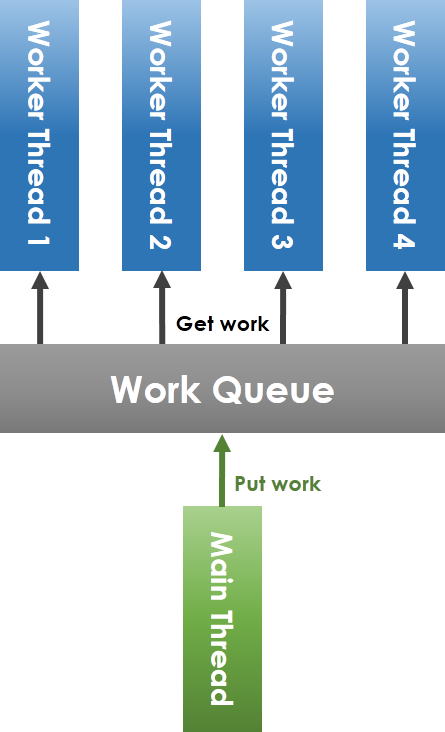
如上圖所示,workqueue (工作佇列) 由 main thread (主執行緒) 和 worker thread 共享,main thread 將任務放進 workqueue,worker thread 從 workqueue 中取出任務執行。要注意到,共享 workqueue 的操作必須在 mutex 的保護下安全進行,main thread 將任務放進 workqueue 時,若偵測到目前待執行的工作數目小於 worker thread 總數,則要透過 condition variable 喚醒可能處於等待狀態的 worker thread。
**lock-free 化 thread pool 實做原理**
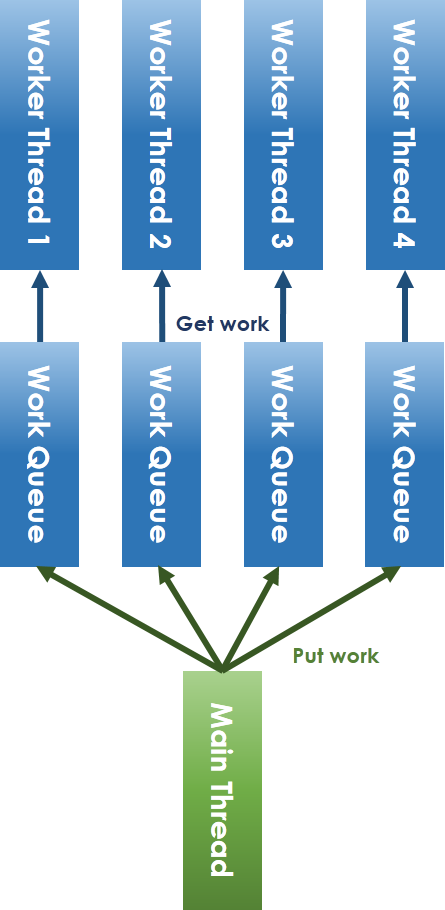
為解決 lock-free 所面臨的議題,我們一定要避免共享資源的競爭 (contention),因此將共享 workqueue 加以拆分成每 worker thread 一個 workqueue 的方式,如上圖。對於 main thread 放入工作和 worker thread 取出任務的競爭問題,可以採取 ring-buffer 的方式避免。在解決了lock 機制後,就只剩下 condition variable 的問題,condition variable 本質上就是提出來解決執行緒之間的通訊議題,不然為了追蹤特定變數,如之前提到的 "count" 變數,還得額外建立執行緒來追蹤。而 semaphore 作為一種通信方式,可以代替之,其大體開發模式為:
```C=
sigemptyset(&zeromask);
sigemptyset(&newmask);
sigaddset(&newmask, SIGXX);
sigprocmask(SIG_BLOCK, &newmask, &oldmask);
while (!CONDITION)
sigsuspend(&zeromask);
sigprocmask(SIG_SETMASK, &oldmask, NULL)
```
**lock-free thread pool 實做說明**
程式碼請見: [LFTPool](https://github.com/xhjcehust/LFTPool)
在 lock-free thread pool 的實做裡頭,有別於常見 thread pool 之處,在於 semaphore 與 condition variable 、排程演算法、增加或減少執行緒數目後的 task migration,另一點則是引入 [ring-buffer](https://en.wikipedia.org/wiki/Circular_buffer),後者參考了 Linux 核心中的 kfifo 實做。
(1) **semaphore 與 condition variable**
semaphore 與 condition variable 的區別,主要在於 condition variable 的喚醒 (signal),對於接收端執行緒而言可以忽略,而在未設定 semaphore 處理函式的情況下,semaphore 的接收會導致接收執行緒,甚至是整個程式的終止。因此,需要在 thread pool 產生執行緒前,事先指定 semaphore 處理函式,如此一來,新建立的執行緒會繼承這個 semaphore 處理函式。在 LFTPool 中,用 SIGUSR1 這個 POSIX signal 來等待「有工作分發給我了」這個事件。「等待事件發生」是 semaphore 的一種功能,但不是 semaphore 唯一的用法。例:把 semaphore 初始化成 0,則可用來等待事件;把 semaphore 初始化成 1,則可用來 mutex。
:::warning
另外因為 POSIX 有另外 semaphore 機制 sem_{wait,post} 等,故在觀念上把此處的用法稱為 semaphore 也很容易混淆。
:::
:::info
原作者刻意用 POSIX signal,是為了展示他的程式是 "lockfree": 「在解决了锁机制之后,就只剩下条件变量的问题了,条件变量本身即解决条件满足时的线程通信问题,而信号作为一种通信方式,可以代替之」。
但 POSIX signal 傳送在 kernel 中當然不是 lock-free 的。觀念上,只要程式在等待事件時要把 CPU 釋放出來,需要進入 scheduler,那個部份的 lock-free 與否就不太有意義了,因為 context switch 比 lock acquire/release 還要慢。
:::
(2) **任務排程演算法**
常見 thread pool 實做的任務排程,主要透過作業系統的 thread scheduler 來達成。考慮到 load-balancing,main thread 放入任務時應採取合適的任務排程演算法,將任務放入對應的 worker thread 隊列,本程式目前已實做 Round-Robin 和 Least-Load 演算法。Round-Robin 即輪詢式地分配工作,Least-Load 即選擇目前具有最少工作的 worker thread 放入。
(3) **Task migration**
在執行緒的動態增加和減少的過程中,同樣基於 load-balancing 的考量,涉及到現有 task 的遷移 (migration) 問題。load-balancing 演算法主要基於平均工作量的想法,即統計目前時刻的總任務數目,均分至每一個執行緒,求出每個工作者執行緒應該增加或減少的工作數目,然後從頭至尾逐一存取,需要移出工作的執行緒與需要移入工作的執行緒執行 task migration,相互抵消。最後若還有多出來的工作,再依次分配。
遷入 (migreate IN) 工作不存在競態,因為加入工作始終由 main thread 完成,而遷出 (migrate OUT) 工作則存在競態,因為在遷出工作的同時,worker thread 可能在同時執行任務。所以需要採用 atomic operation 加以修正,其主要思想就是預先擷取 (prefetch) 的技巧,大致實做程式碼如下:
```C=
do {
work = NULL;
if (thread_queue_len(thread) <= 0) // thread_queue_len() 必須是 atomic
break;
tmp = thread ->out;
// prefetch work
work = &thread->work_queue[queue_offset(tmp)];
} while (!__sync_bool_compare_and_swap(&thread->out,
tmp, tmp + 1));
if (work) do_something();
```
* Test-and-Set instruction: [](https://en.wikipedia.org/wiki/Test-and-set)[https://en.wikipedia.org/wiki/Test-and-set](https://en.wikipedia.org/wiki/Test-and-set)
* `__sync_bool_compare_and_swap` 是 GCC atomic builtin function 之一: [](https://gcc.gnu.org/onlinedocs/gcc-5.3.0/gcc/_005f_005fsync-Builtins.html#_005f_005fsync-Builtins)[https://gcc.gnu.org/onlinedocs/gcc-5.3.0/gcc/_005f_005fsync-Builtins.html#_005f_005fsync-Builtins](https://gcc.gnu.org/onlinedocs/gcc-5.3.0/gcc/_005f_005fsync-Builtins.html#_005f_005fsync-Builtins)
* C11 標準正式將 atomic operation 納入,請見: [](http://en.cppreference.com/w/c/atomic)[http://en.cppreference.com/w/c/atomic](http://en.cppreference.com/w/c/atomic)
Atomic 是種同步機制,不須透過 explicit lock (如 mutex),也能確保變數之間的同步。Linux 核心提供了對應的型態 `atomic_t`。而 gcc 也提供了內建的函式 (built-in functions),專門處理 atomics,如下:
```
type __sync_fetch_and_add (type *ptr, type value, ...)
type __sync_fetch_and_sub (type *ptr, type value, ...)
```
上面的 "type" 可以是 int8 .. int64。
最常用到的就是「加」和「減」的操作,使用如下:
```C=
int val = 0;
__syn_fetch_and_add(&val, 1);
```
這是種輕量級的同步機制,若只是對一個變數去做同步,實在不需要透過 mutex。在真實硬體環境中,atomics 的效能會比 `pthread_mutex_t` 好許多。
atomics 通常會伴隨著探討 memory barrier,這是因為編譯器進行最佳化時,往往會為了最佳化去變更指令的順序,但在特定的狀況下,往往會帶來後遺症,為了避免衝擊,gcc 也提供以下內建函式來處理 memory barrier:
__sync_synchronize()
在執行緒的動態減少後,原先執行緒上未能執行完的任務,只需要由 main thread 再次根據任務排程演算法重新分配至其他存活的 worker thread 隊列中即可,不存在上述問題,當然,此時可以同時執行 load-balancing 演算法加以最佳化。
(4) ring-buffer

ring-buffer 實做主要參考了 Linux 核心中 kfifo 的實做,如下圖所示:
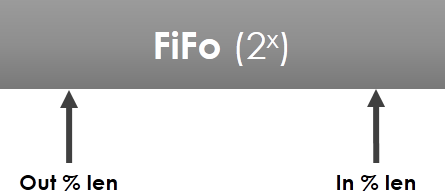
環狀佇列長度為 2 的整數次方,out 和 in 下標一直遞增至越界後迴轉,其類型為 `unsigned int`,即 out 指標一直追趕 in 指標,out 和 in 映射至 FiFo 的對應下標處,其間的元素即為隊列元素。
## 案例分析
### 對 Linked-List 排序
從 [Bubble sort](https://en.wikipedia.org/wiki/Bubble_sort) 談起,如何有效操作不連續記憶體
* [Linked List Bubble Sort](http://faculty.salina.k-state.edu/tim/CMST302/study_guide/topic7/bubble.html) (*)
* [Linked List Algorithms](http://c.learncodethehardway.org/book/ex33.html)
* [A Comparative Study of Linked List Sorting Algorithms](https://www.cs.mtu.edu/~shene/PUBLICATIONS/1996/3Conline.pdf), Ching-Kuang Shene [[冼鏡光](https://zh.wikipedia.org/zh-tw/%E5%86%BC%E9%8F%A1%E5%85%89)] (1996)
* 「冼」發音為ㄒㄧㄢˇ
* [Linked Lists: Locking, LockFree, and Beyond](http://www.cs.nyu.edu/courses/fall05/G22.2631-001/lists.slides2.pdf)
* **[concurrent-ll](https://github.com/jserv/concurrent-ll)**: concurrent linked-list 實作
* [ size = **128** ]

* [ size = **1024** ]
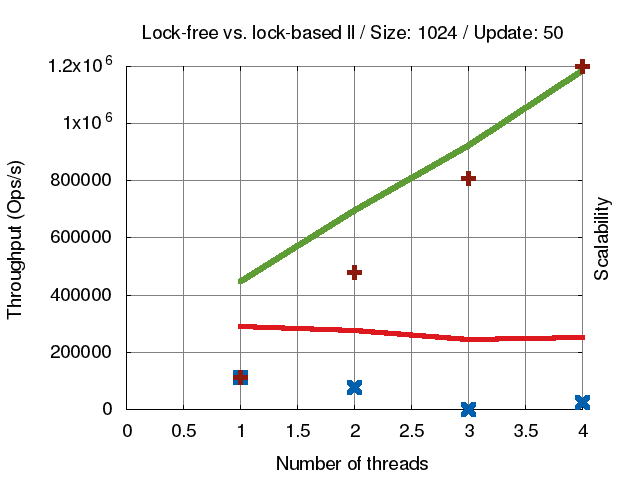
* [ size = **8192** ]

### Hungry Birds
* 展示典型 Producer-Consumer Problem 在多執行緒、多核心環境的運作
* [hungry-birds](https://github.com/jserv/hungry-birds) implements unbounded lockless single consumer multiple producer FIFO queue.
* 延伸閱讀: [C11 atomic variables and the kernel](https://lwn.net/Articles/586838/)
### MapReduce with POSIX Thread
* 詳見共筆: [MapReduce with POSIX Thread](https://hackmd.io/s/Hkb-lXkyg)
### 通用伺服器架構
* 詳見共筆: [server-framework](https://hackmd.io/s/B1s8hX1yg)
### Concurrent B+tree
* 提出一個並行化的 B+ tree 實作,並探討其中資料結構設計、read-write lock,以及該如何延展為一個高效能的資料庫系統
* 詳見共筆: [concurrent B+tree](https://hackmd.io/s/SyjKs-mxg)
 Sign in with Wallet
Sign in with Wallet
 Sign in with Wallet
Sign in with Wallet